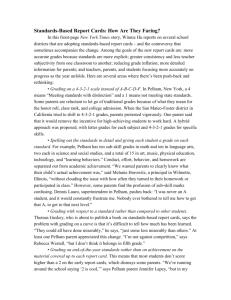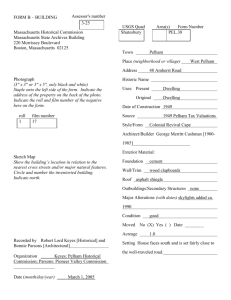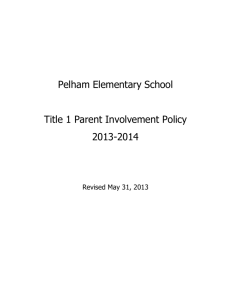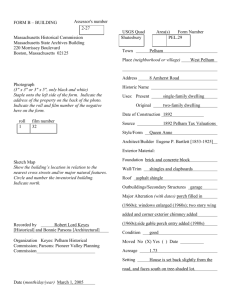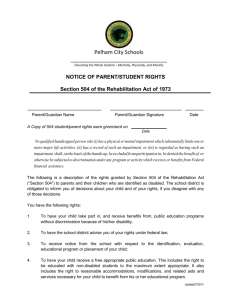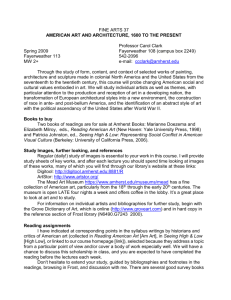18 Amherst Road - Pelham Library
advertisement
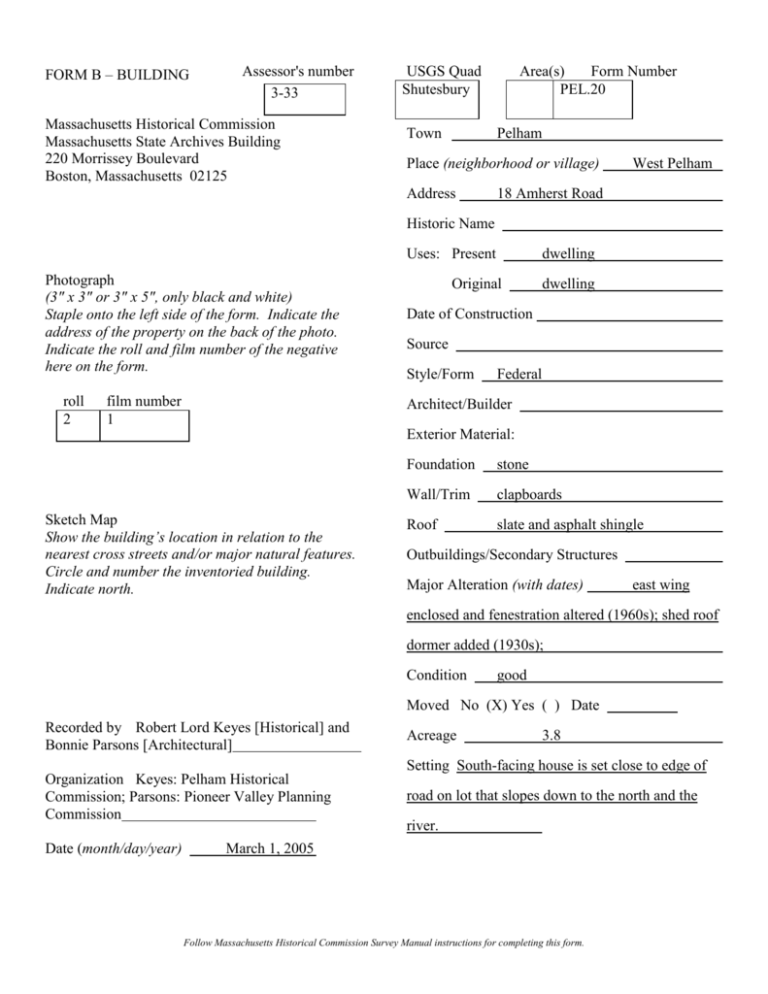
FORM B – BUILDING Assessor's number 3-33 Massachusetts Historical Commission Massachusetts State Archives Building 220 Morrissey Boulevard Boston, Massachusetts 02125 USGS Quad Shutesbury Town Area(s) Form Number PEL.20 Pelham Place (neighborhood or village) Address West Pelham 18 Amherst Road Historic Name Uses: Present Photograph (3" x 3" or 3" x 5", only black and white) Staple onto the left side of the form. Indicate the address of the property on the back of the photo. Indicate the roll and film number of the negative here on the form. roll 2 film number 1 dwelling Original dwelling Date of Construction Source Style/Form Federal Architect/Builder Exterior Material: Sketch Map Show the building’s location in relation to the nearest cross streets and/or major natural features. Circle and number the inventoried building. Indicate north. Foundation stone Wall/Trim clapboards Roof slate and asphalt shingle Outbuildings/Secondary Structures Major Alteration (with dates) east wing enclosed and fenestration altered (1960s); shed roof dormer added (1930s); Condition good Moved No (X) Yes ( ) Date Recorded by Robert Lord Keyes [Historical] and Bonnie Parsons [Architectural] Acreage 3.8 Setting South-facing house is set close to edge of Organization Keyes: Pelham Historical Commission; Parsons: Pioneer Valley Planning Commission Date (month/day/year) road on lot that slopes down to the north and the river. March 1, 2005 Follow Massachusetts Historical Commission Survey Manual instructions for completing this form. BUILDING FORM ARCHITECTURAL DESCRIPTION see continuation sheet Describe architectural features. Evaluate the characteristics of this building in terms of other buildings within the community. This is one of the oldest remaining houses in West Pelham. It is a one-and-a-half story, center chimney cape house with a side gable roof. It is a simple three bays wide and two bays deep and there is a one-story wing on the west that has been converted from a kitchen/woodshed to residential/garage use. In comparison to 17 Amherst Road that sits on relatively high foundations, this Federal house has low stone foundations. What was probably 6/6 window sash beneath a molded window surround has been replaced with a 2/2 configuration. The house has a wide skirt board and its windows touch the eaves. Centered on the roof is an added shed roof dormer. On the west elevation is an ell of one-and-a-half stories that has an exposed basement due to the slope of the land. The center entry of the house has a paneled door and a plane wide board surround. HISTORICAL NARRATIVE see continuation sheet Discuss the history of the building. Explain its associations with local (or state) history. Include uses of the building, and the role(s) the owners/occupants played within the community. 18 Amherst Road was originally part of Home Lot No. 32 drawn by William Johnson in 1739. The house at 18 Amherst Road probably dates to before 1800. It is located on Amherst Road which was the former 6th Massachusetts Turnpike from 1799 until 1820 (running from Amherst to Shrewsbury). It is also abuts two important West Pelham Mills, the Allen Mill [Bigelow Mill Site A1] and the Montague City Fish Rod Factory [Bigelow Mill Site A-2]. The earliest Pelham date with reference to 18 Amherst Road is an 1897 obituary of John Newton Parmenter [1815-1897] in the Northampton Daily Herald which states that Parmenter “was born nearly 83 years ago in the house in which he died…” This house is 18 Amherst Road. John Parmenter [ca. 1782-1855], father of John Newton Parmenter and also of “History of Pelham” [1898] author Charles Oscar Parmenter [1833-1913], probably came to Pelham by 1806 or 1808. In “History of Pelham,” Charles writes about his father: “About the year 1808, John Parmenter set up a carding machine in a building back of the sawmill, now owned by L. W. Allen…” This mill, identified by Paul J. Bigelow [19372001] as Bigelow Mill Site A-1 and later known as the Allen Mill, was located just north of 18 Amherst Road. [Bigelow himself, however, writes that John Parmenter first set up his carding shop at Bigelow Mill Sites A-3 (in 1806) and later at Mill Site A-4 (in 1808), both located about a half-mile east along Amethyst Brook. But, on balance, son Charles O. Parmenter is closer to being a contemporary source in fixing the location of his father’s carding machine.] The earliest contemporary Pelham reference to 18 Amherst Road is Hampshire County Deed 40-217 [1817] wherein Pelham Gentleman John Parmenter takes out a mortgage from Grove Wright Hannum [1791-1858], whose father, Capt. David Hannum [ca. 17631848], lived across the street at 17 Amherst Road. Parmenter put up 3 acres with buildings, “being the same whereon the said John now lives.” Presumably John Follow Massachusetts Historical Commission Survey Manual instructions for completing this form. Parmenter moved into 18 Amherst Road sometime between ca. 1806 and 1815 (when son John Newton was born) and, also presumably, Parmenter did not build the house, but purchased an existing one. [Speculation: Could 18 Amherst Road have been the “home farm” for Home Lot No. 32 laid out in 1739?] Several candidates have been identified as being previous residents of 18 Amherst Road, but their possible residence there has not yet been proven. Mabel H. Brinn Lumley [1908-1989], recalls 18 Amherst Road [in a “Form B— Building” filing with the Massachusetts Historical Commission, in 1974]: The “Living room has wide chick floor boards, hand planed. In 1900 there was a fire and in remodeling the house, a Dutch oven in the living room was not replaced. Apparently the room was the only room in the original house. [The] cellar is a laid native field stone construction. When the upstairs was renovated, newspapers calling for volunteers for the Revolutionary war were discovered pasted to the walls.” It is possible that John Parmenter was resident at 18 Amherst Road for the 1810 Federal Census. There are three members in his household: 1 male age 26 to 45, John Parmenter; 1 female age 16 to 26, wife Hannah Dickinson Parmenter [ca. 1792-1862], and 1 female age 0 to 10, daughter Mary Ann Parmenter [1809-1892] [Mary was born in Hatfield, presumably at her mother’s relatives]. Additional children born to the Parmenters were: John Newton Parmenter [1815-1897], Erasmus Darwin Parmenter [b. 1824], and Charles Oscar Parmenter [1833-1913]. [Erasmus, in fact, was delivered by Dr. Isaac Guernsey Cutler (1782-1834), the same physician who later delivered Emily Dickinson.] These same family members also appear to prove out in the 1820, 1830, 1840 and 1850 Census. In 1820, John was listed as being engaged in manufacturing. In 1850, he is listed as a 68year-old carpenter, while Erasmus was a 25-year-old mechanic, and Charles, a 17-yearold farmer. Charles recalled [in 1898], that his father “made ploughs for use in Pelham and the neighboring towns…and about the year 1840 contracted to build some that were shipped to Illinois.” [These Illinois contracts may have gone to relatives and former neighbors as several West Pelham families had moved to northern and western Illinois at about that time.] John Parmenter’s first Pelham Tax Valuation showing details is in 1831. It lists 11 acres, 1 horse and 2 cows. Parmenter is listed as owning 18 acres in 1835, 28 acres in 1839, and 13 acres in 1850. Parmenter was a Justice of the Peace and, in 1841, Representative to the General Court. In 1830, he surveyed the map of Pelham [along with Ziba Cook (17911868)] as required by the Commonwealth of all towns that year. In 1836 the Hampshire County Commissioners met at Parmenter’s house regarding the designation of Meetinghouse Road as a county road. John Parmenter died in 1855. His heirs continued to own 18 Amherst Road until 1862 when wife Hannah died. The heirs were listed on the 1861 Tax Valuations as owning 13 acres, 1 house, 1 barn, 1 shop, 1 cow, 1 horse and 1 wagon. The Parmenters, however, continued to own 18 Amherst Road until 1915. Son Charles owned half of the property between 1863 and 1871. [It is not certain who owned the other half, though, presumably it was another Parmenter heir.] Charles owned a quarter of the property and sister Mary owned three-quarters between 1872 and 1880. From 1881 until 1887, Mary continued to own three-quarters, shared now with brother Erasmus’ wife, presumably Resign N. Murphy Parmenter. Mary was sole owner from 1888 until 1891. Follow Massachusetts Historical Commission Survey Manual instructions for completing this form. After her death in 1892, Charles and John Newton Parmenter owned the property between them. After John’s death in 1897, 18 Amherst Road was owned by Charles until he died in 1913 [heirs of Charles owning 12 acres between 1913 and 1915]. Mary Parmenter was single and appears to have lived all her life at 18 Amherst Road. John Newton Parmenter was a Springfield and Boston resident for many years, but returned to 18 Amherst Road ca. 1891. Erasmus Parmenter last lived in Pelham in 1850. Charles Parmenter apparently divided his time between Pelham and Amherst. In Amherst he was Town Moderator and had various trades, including sewing machine and insurance agent. In Pelham he was a hood maker. He was also Representative to the General Court in 1880. In 1898, during a period when Americans were writing and publishing both local histories and genealogies (often in response to non-English migration to America), Charles wrote “History of Pelham.” He spent his last three years in Hatfield and presumably 18 Amherst Road was rented. A photograph of 18 Amherst Road appears on page 340a of “History of Pelham.” About 1900, 18 Amherst Road was subject of a photograph by the Howes Brothers of Ashfield. Eugene P. Bartlett [1853-1925], owner of the Montague City Fish Rod Factory [22 Amherst Road], and also Parmenter’s neighbor to the east [at 20 Amherst Road], purchased 18 Amherst Road in 1915. Bartlett often bought and built properties in West Pelham for residences for use by relatives and employees of the Fish Rod Factory. In 1915, Bartlett would have owned 8, 18, 20 and 22 Amherst Road—all contiguous properties—among many others. Presumably, 18 Amherst Road was once more rented for a time. The lot was now 10 acres in 1916. After Bartlett’s death, 18 Amherst Road was sold to William Henry Spalding [18601934] and Luella Dora Knight Spalding [1877-1959] in 1927. 18 Amherst Road was now 4 acres. William was a Sandpaperer in the Fish Rod Factory. They had one surviving son, Dr. Manfred Root Spalding [1902-1980], who lived with them. Manfred was a practicing physician in Worcester by 1927. Mrs. Spalding, known as Dora, grew up in the Knight’s Corners-Packardville section of Pelham, and faithfully attended Pelham Old Home Day annually. She hosted the Knight Family Reunion at 18 Amherst Road in July, 1935. William Spalding died in 1935. Dora Spalding raised her nephew, Curtis Raymond Knight, Jr. [1923-1999], at 18 Amherst Road. After graduating from Amherst High School in 1942, Knight joined the army. In “February, 1943. Pfc. Knight received shrapnel wounds March 11, 1943, in the battle on Hauwie Islands in the South Pacific area. He has received the Purple Heart and citation for bravery.” He also was “awarded the Soldiers’ medal for heroism at Leyte Province, Philippine Islands.” [Gazette, March 13, 1945.] In all, 65 Pelham men served during World War II, and six were wounded [one killed]. Dora sold 18 Amherst Road to Curtis Knight and his wife, Nathalie C. Pearl Knight [b. 1928], in 1951. The Knights had three children and operated the Royal Grocery Store at 25 Amherst Road from 1961 until 1982. In 1965, the Knights sold 18 Amherst Road and moved to 8B Harkness Road, which they built. Curtis Knight later became Pelham Police Chief from 1969 until 1986. Follow Massachusetts Historical Commission Survey Manual instructions for completing this form. 18 Amherst Road was now listed as 3.8 acres when the property was transferred to Ralph Silas Petersen [1903-1991] and Mary S. Petersen [1898-1991] in 1965. The Petersens owned the former Eugene P. Bartlett house next door at 20 Amherst Road. By 1991, 18 Amherst Road was owned by the Petersen’s surviving daughters, Barbara A. Petersen [b. 1927] and Caroline M. Petersen Gouin. Barbara, a teacher, has resided there for over thirty years. BIBLIOGRAPHY and/or REFERENCES see continuation sheet Hampshire County Deeds 40-217 [1817]; 442-61 [1890]; 1108-68 [1951]; 1433-292 [1964]; 1455-204 [1965]; 3618-58 [1990]. Hampshire County Plan Book 77-83 [1971]. Pelham Tax Valuations, Annual Reports, and Street Lists, [Town Vault, Town of Pelham; and History Room, Pelham Free Public Library]. Parmenter, C[harles] O[scar], “History of Pelham,” [Amherst, MA: Carpenter and Morehouse, 1898], pp. 24, 25, 30, 31, 242, 247, 340a, 502, 503. Parmenter, Charles Oscar, Charles Oscar Parmenter Collection, [in “Pelham Historical Society Archives Collection,” History Room, Pelham Free Public Library]. Pelham Vital Records, [Town Clerk’s Office, Town of Pelham]. Federal Census, 1810-1930. Massachusetts Census, 1855 and 1865. Board of Assessors, Town of Pelham, Revaluation Card, 18 Amherst Road, 1982. Aldrich, Kenneth R., Helen [Mimi] M. Cary, Emma Weaver and Pearly P. Keyes, Jr.: Personal Recollections, to Robert Lord Keyes, 2003 and 2004. Maps of Pelham: 1854 Scott and McLearn, 1856 Whitlock, 1860 Walling, and 1873 Beers [Copies in History Room, Pelham Free Public Library]. Allen, Harry W., “Life in West Pelham, Massachusetts from 1892 to 1918,” [Ms., 1976], pp. 6-7, [Copy in History Room, Pelham Free Public Library]. Bigelow, Paul, “Wrights and Privileges: The Mills and Shops of Pelham, Massachusetts, from 1740 to 1937,” [Athol, MA: Haley’s, 1993], pp. 3, 19-23, 24, 35, 37-38. Cutler, Dr. Isaac G., List of Births Attended, [Ms., 1805-1833], [Special Collections, Jones Library, Amherst, MA]. Howes Brothers, 18 Amherst Road, Pelham, Mass., [photograph, n.d., ca. 1900], [Photograph No. 3049C, Ashfield Historical Society, Ashfield, Mass. Pelham Old Home Association, Registration Book, [Ms.], [in Pelham Historical Society Archives Collection, History Room, Pelham Free Public Library]. Follow Massachusetts Historical Commission Survey Manual instructions for completing this form. 18 Amherst Road, Pelham, Massachusetts, Form B—Building, by Mabel H. Brinn Lumley, June 4, 1974, [Massachusetts Historical Commission, Boston]. Amherst Bulletin, Dec. 29, 1987. Greenfield Recorder, July 6, 1959. Northampton Daily Herald, Aug. 2, 1897. [Northampton, MA] Daily Hampshire Gazette, March 12, 1913; April 4, 1927; July 3, 1935; March 13, 1945; June 1, 1996; Nov. 13 and 15, 1999. Keyes, Robert Lord, 40 South Valley Road, Pelham, MA 01002, Pelham, Massachusetts History Project: Genealogical and Historical Research. Recommended for listing in the National Register of Historic Places. If checked, you must attach a completed National Register Criteria Statement form. Follow Massachusetts Historical Commission Survey Manual instructions for completing this form. Massachusetts Historical Commission Address State Archives Facility 220 Morrissey Boulevard Boston, Massachusetts 02125 Community Pelham Property 18 Amherst Road Area(s) Form No. PEL.20 National Register of Historic Places Criteria Statement Form Check all that apply: Individually eligible Eligible only in an historic district Contributing to a potential historic district Potential historic district Criteria: A Criteria Considerations: B C A D B C D E F G Statement of Significance by ___Bonnie Parsons________________________________ The criteria that are checked in the above sections must be justified here. This property contributes to the potential West Pelham Historic District. The district is significant according to criteria A and C and it has local significance. West Pelham is significant as the site of 18th century settlement at four mill sites, one of which exists today, and for its association with events of Shays’s Rebellion after the Revolutionary War. West Pelham, known during the late 19th and early 20th century as “Pelham City” represents a 19th century agricultural and light industrial village that superceded Pelham Center as the town center due to the long term success of its industry attracting and sustaining workers and to its development in the early 20th century as a suburban area for population spillover from Amherst, long a college town and intellectual center of the region. A late 19th century resort destination, West Pelham is also important as it retains a building from this era, and from the resort Orient Springs. The district retains buildings from its 19th century agricultural, resort and industrial past as well as from its early 20th century suburban phase, which continues to the present. There are fine examples of Federal and Greek Revival farmsteads. With a Queen Anne store and single and double houses from the Colonial Revival and Craftsman styles applied to bungalow, cape and Four-square forms - the district’s stylistic range as a home to workers and suburban commuters is exemplary. Follow Massachusetts Historical Commission Survey Manual instructions for completing this form.
